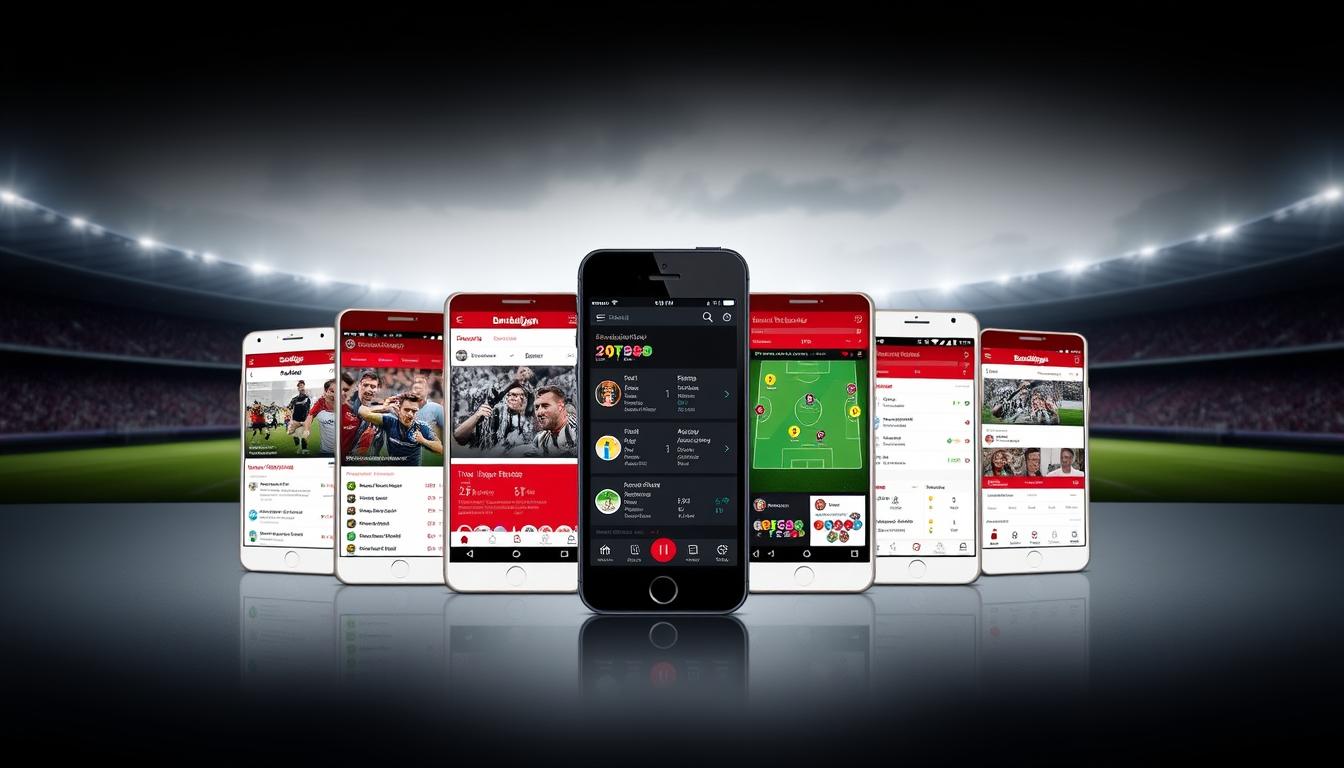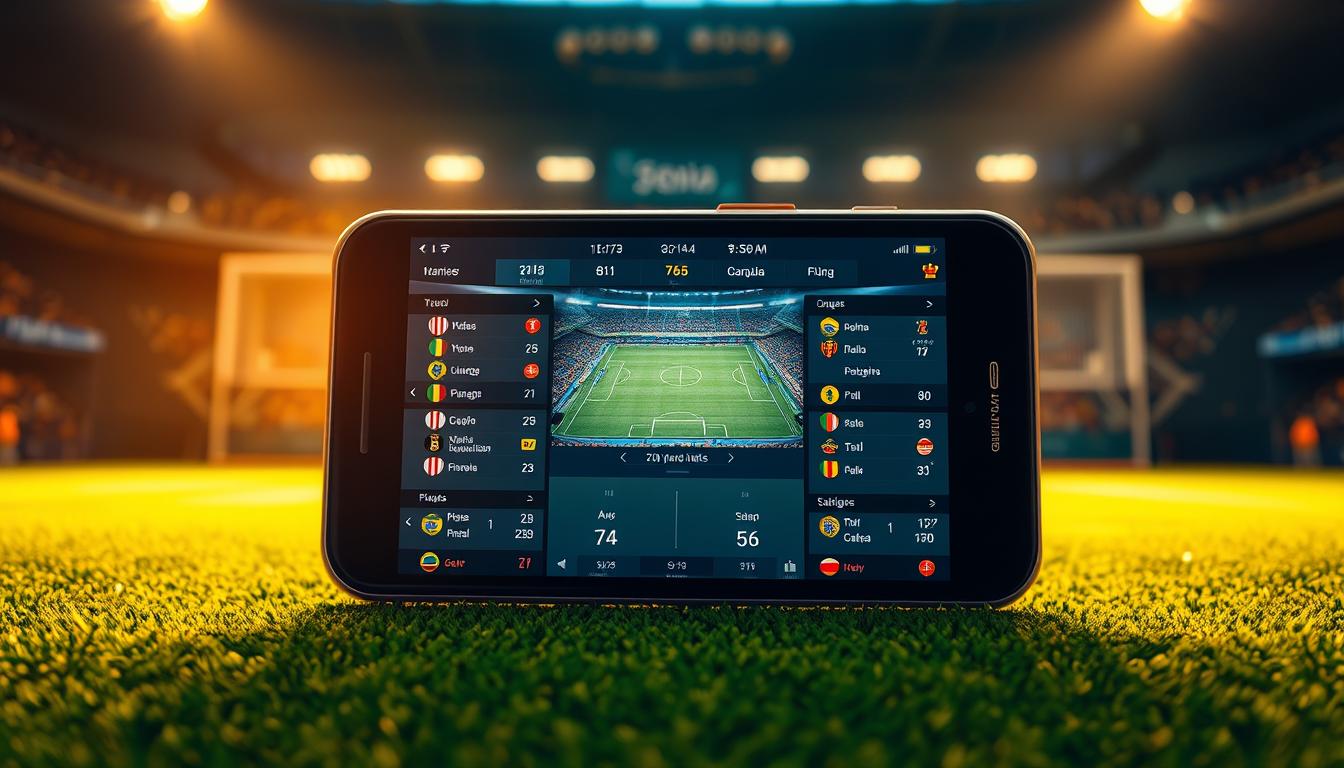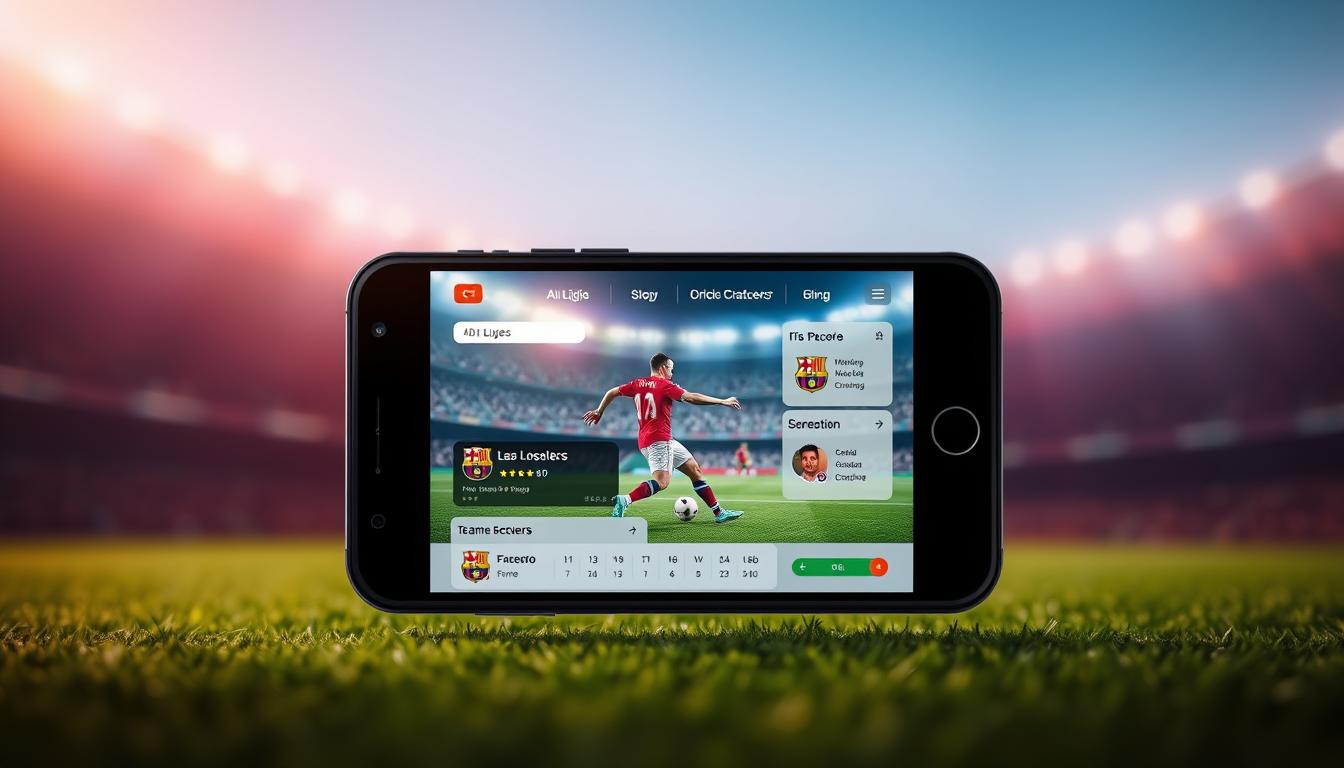Anúncios
Ever thought your slow phone could play the latest games without lag? Low-latency emulators might be the answer for mobile gamers with slow devices. These tools aim to make games run smoothly, even on phones that usually struggle. We’ll explore the top emulators, how to optimize them, and the latest in emulator tech. This will help you enjoy your mobile games to the fullest.
Understanding Low-Latency Gaming
Low-latency gaming means less delay between your actions and the game’s response. This is key for interactive games, especially in competitive ones. It makes the game more fun and rewarding for players.
Latency’s impact is more than just numbers. Low latency makes interactions smooth, improving the user experience. But high latency can cause frustrating delays, hurting a player’s performance. This is especially true in multiplayer games, where timing is everything.
Anúncios
Knowing about latency helps us see its importance in gaming. Developers can make games better by focusing on latency. This leads to quicker controls and smoother movements. For more tips on improving gaming, check out this guide here.

Challenges of Gaming on Slow Phones
Gaming on slow phones can be really tough. You might see lag, frame drops, and poor graphics. These issues make playing games frustrating.
Anúncios
Devices with little RAM and CPU power struggle to handle games. Older operating systems make things worse, causing slow loading and unresponsive gameplay. As games get more demanding, slow phones can’t keep up.
This can ruin multiplayer sessions, making it hard to play with friends. If you want to play the newest games, you might not be able to. This can make your gaming experience less fun.

Benefits of Using Emulators for Mobile Gaming
Emulators are great for mobile gamers, especially those with slower devices. They make it possible to play games that wouldn’t work otherwise. This is because they run games on faster systems, making games smoother and faster to load.
One big plus is multi-instance support. This lets players run many games or apps at once. It makes gaming more fun and productive. Plus, it ensures games look good on any system, improving the overall gaming experience.
Using emulators can also save money. It’s cheaper than buying new hardware. It uses what you already have and saves money on upgrades. Plus, better graphics and customizable controls make games more fun and easy to play.
| Emulator Benefits | Impact on Mobile Gaming |
|---|---|
| Performance Enhancement | Smoother gameplay with reduced lag |
| Multi-instance Support | Run multiple games simultaneously |
| Cost-Effectiveness | Avoids the need for expensive hardware upgrades |
| Graphics Improvement | Enhanced visual experience |
| Customizable Controls | Personalizes gameplay for each user |
Overview of Low-Latency Emulators
Low-latency emulators are key for better gaming on slow mobile devices. They make games run smoothly, reducing lag. This is thanks to their ability to mimic high-end system performance.
There are many types of emulators, each for different needs. You can find Android-specific ones like BlueStacks or cross-platform options. The right emulator can greatly improve your gaming experience.
These emulators use smart tech to work well with your device’s hardware. They manage resources to give you a better gaming experience. This means you can play your favorite games without needing new hardware.
Best Low-Latency Emulators for Slow Mobile Devices
Choosing the right tools is key for better mobile gaming on slower devices. The best low-latency emulators offer better graphics and faster response times. Here are three top picks for different gaming needs.
BlueStacks
BlueStacks is a top choice for low-latency emulators. It supports many games and boosts performance with customizable settings. Its easy-to-use interface makes it great for all gamers.
With BlueStacks, you get less lag and better graphics. This means a smoother gaming experience, even on devices with limited power.
LDPlayer
LDPlayer is perfect for gamers who want top performance without losing quality. It supports the latest Android games and focuses on low latency. This ensures smooth action in real-time.
LDPlayer also has advanced settings for tweaking graphics and performance. It’s ideal for playing demanding games on slower devices.
NoxPlayer
NoxPlayer is great for those who want a balance of features and performance. It’s known for its stability and speed, offering a top-notch gaming experience on less powerful devices.
NoxPlayer lets you customize controls and supports playing multiple games at once. Its efficient performance and focus on the user make it a leading emulator.
Performance Optimization Techniques for Emulators
Improving emulator performance can make gaming better on slower devices. It’s all about using system resources wisely and tweaking emulator settings. These steps help make games run smoothly and cut down on lag.
Allocating System Resources
It’s crucial to manage system resources like RAM and CPU well for better emulator performance. Most emulators let you set how much RAM and CPU to use. More resources mean better stability and speed.
Closing apps you don’t need can also help. This frees up more resources for the emulator. It makes your gaming experience smoother without overloading your device.
Settings Adjustments for Smooth Gameplay
Getting the right settings in your emulator is key for top performance. Changing graphics settings, like resolution and rendering, can greatly improve gameplay. For example, lowering the resolution can boost frame rates on less powerful devices.
Turning on hardware acceleration can also make a big difference. It uses your device’s GPU to speed things up. Adjusting these settings ensures your games run smoothly, fitting your device’s capabilities.
Trends in Emulator Technology
New trends in emulator technology are changing how we play games. Cloud-based emulation lets gamers use powerful tools without needing expensive hardware. This makes games available on many devices, even those with less power.
Artificial intelligence (AI) is also making emulators smarter. AI helps make games more fun and run better. It learns what players like and adjusts the game to fit their style.
Augmented reality (AR) and virtual reality (VR) are becoming big in emulators too. These features help create games that feel real. They open up new ways to play and mix different experiences together.
Improving graphics and making games work on all devices is key. Developers aim to make games look great without slowing them down. This way, players can enjoy their games on any device they choose.
Features to Look for in an Emulator
Choosing the right emulator can make a big difference in your gaming experience, especially on slower devices. Key features to look for include multi-instance support. This lets you run multiple games or apps at once, perfect for those who like to multitask or try out different titles.
Cloud access is another must-have. It offers a smooth gaming experience on any device. You can save your progress and play games on any machine, without being tied to one.
User-friendly emulators come with customizable control mapping. This lets you adjust controls to fit your preferences. It makes playing games more comfortable and ensures controls are easy to use and tailored to each game.
System compatibility is also vital. A good emulator should work well on many devices, with little lag and high performance. It’s important to check these features to find the best emulator for your gaming needs.
The following table summarizes key features to consider when selecting an emulator:
| Feature | Importance | User-Friendliness |
|---|---|---|
| Multi-Instance Support | Allows multiple games to run simultaneously | Enhances multitasking for users |
| Cloud Access | Enables cross-device gameplay | Convenient for saving and accessing games from anywhere |
| Customizable Control Mapping | Improves control comfort | Adaptable to different game preferences |
| System Compatibility | Ensures smooth performance on various devices | Wide range of accessibility |
Comparing Free vs Paid Emulator Options
Choosing between free and paid emulators can greatly affect your gaming on slow mobile devices. Free emulators are good for casual gamers because they’re free. But, they might have ads, limited support, and fewer updates. This can lead to problems with some games.
Paid emulators offer a better experience. They have cool features like better graphics and faster loading. They also get updates regularly, keeping your games running smoothly. Even though they cost more, they’re worth it for serious gamers.
Looking at a table comparing free and paid emulators can help. It shows the main differences. This can help you decide based on what you need and how much you can spend.
| Feature | Free Emulators | Paid Emulators |
|---|---|---|
| Initial Cost | Free | Varies ($10-$50) |
| Customer Support | Limited | Comprehensive |
| Updates Frequency | Infrequent | Regular |
| Ad Experience | Ads Present | No Ads |
| Advanced Features | Basic | Enhanced |
By looking at the good and bad of each, you can choose wisely. This choice should match your gaming needs and budget.
User Experience: Community Feedback and Reviews
Users share their experiences on different platforms, giving us a clear view of emulator performance. Forums and review sites are filled with real-life stories. They talk about how easy to use and fun the games are.
Some praise BlueStacks and LDPlayer for their user-friendly design and smooth gameplay. Others mention the challenges they faced, like setting it up or dealing with resource issues.
Reviews often focus on how well an emulator works with different systems. People say some emulators run great on slow devices, while others don’t. They also talk about tweaks that can make games run better.
Users also share tips for fixing common problems. This helps everyone solve issues together. It shows what each emulator does well and what it struggles with.
By reading what others say, you can make a better choice. This way, you can find the best emulator for your needs.
Developing with Emulators: Beyond Gaming
Emulators do more than just play games. They play a big role in emulator development and app testing. Developers use them to check how apps work on different devices. This makes sure apps run well on any device, no matter the differences.
By using emulators, developers can test apps on many devices at once. This helps find and fix problems before they reach users. It also makes apps work better on many platforms.
Emulators are key in making sure software is top-notch. They help developers make better apps for everyone. Emulators are not just for games; they’re vital for any team making apps.
Conclusion
Low-latency emulators are key for gamers wanting to play their favorite games on slow devices. They make gaming on low-end phones better and help users get the most out of their devices. Knowing the best emulators and how to use them can really improve your gaming.
The future of emulators is bright, thanks to new tech that makes them work better. Tools like BlueStacks and LDPlayer keep improving, making games run smoothly. This means gamers can enjoy great games, no matter what their device is.
When gaming on low-end devices, use the tips from this article to pick the right emulator. For more tips on making your device better for gaming, check out this resource. Emulators are always getting better, so staying up-to-date will enhance your gaming experience.
FAQ
What is low-latency gaming?
Low-latency gaming means less delay between when you press a button and when the game responds. It’s key for a fun gaming experience. It makes games feel more responsive and satisfying, especially in competitive games.
How can emulators improve gaming on slow mobile devices?
Emulators make games run smoothly on slower devices. They do this by optimizing performance. Features like multi-instance support and customizable controls help a lot.
What challenges do gamers face on slower mobile devices?
Gamers often deal with lag, dropped frames, and poor graphics. These issues come from limited RAM, CPU power, and old operating systems. It makes gaming frustrating.
What should I consider when choosing an emulator?
Look for multi-instance support, cloud access, and customizable controls. Also, consider user-friendly interfaces and system compatibility. This helps find the right emulator for you.
Are there any trends in emulator technology?
Yes, new trends include cloud-based emulators and support for AR and VR. There’s also a push for high-fidelity graphics and cross-platform use.
How do free emulators compare to paid options?
Free emulators have fewer features and less support. Paid ones offer more and are updated regularly. This lets users pick based on their needs and budget.
How do developers use emulators in app development?
Developers use emulators for testing, debugging, and monitoring app performance. They simulate different devices to optimize apps effectively.
What are some of the top low-latency emulators available?
Top emulators include BlueStacks, LDPlayer, and NoxPlayer. They’re known for improving performance on slow devices.




